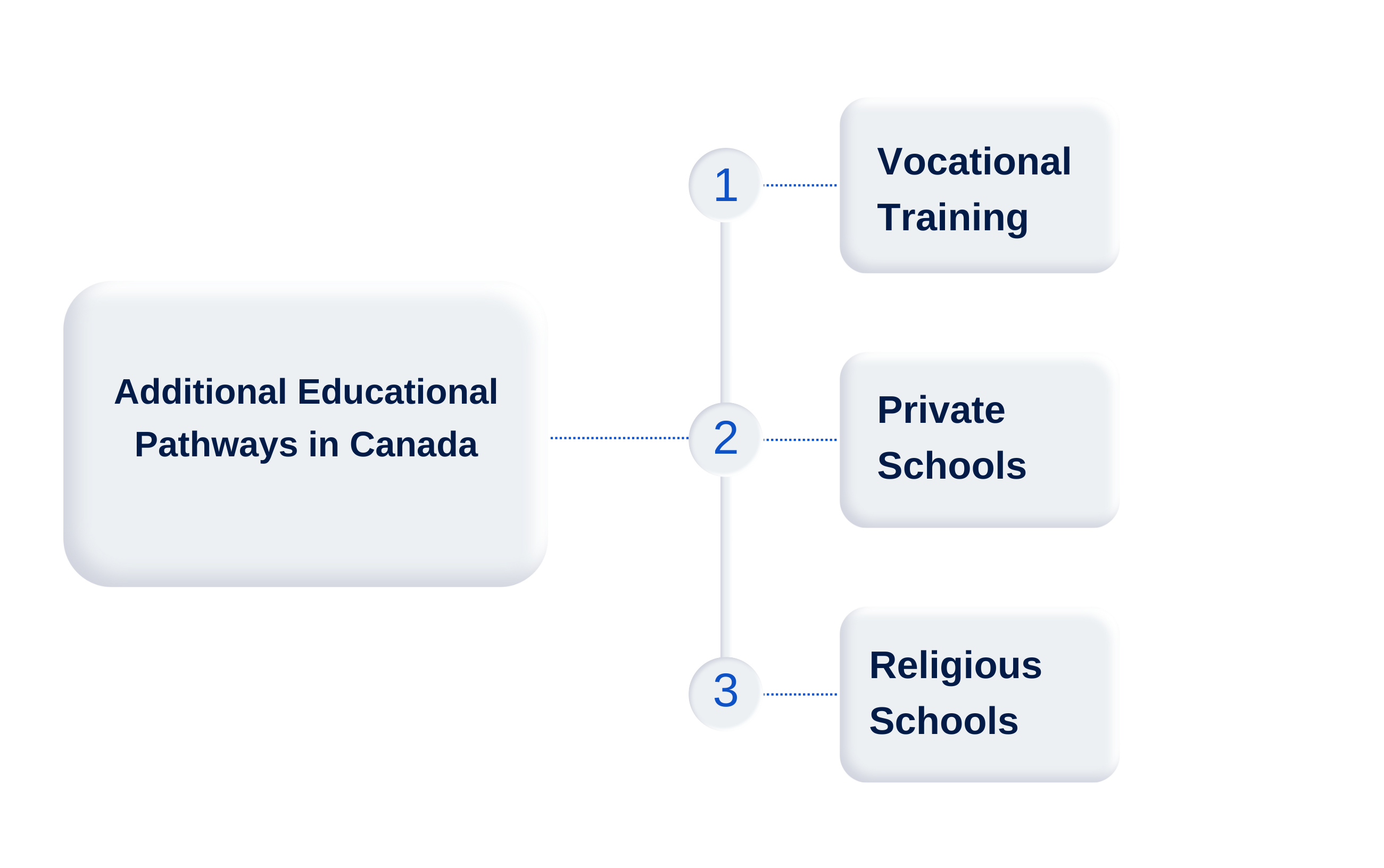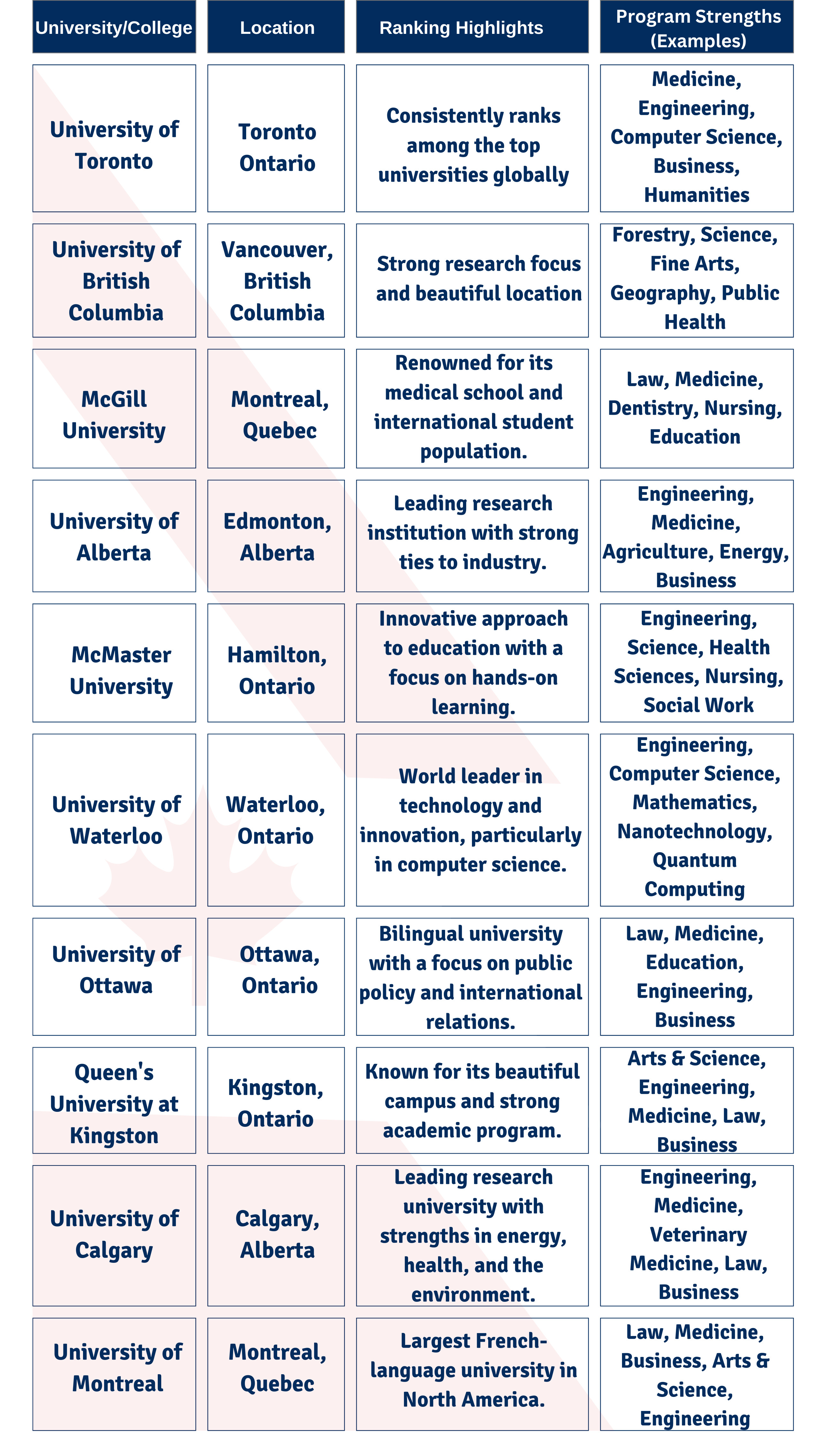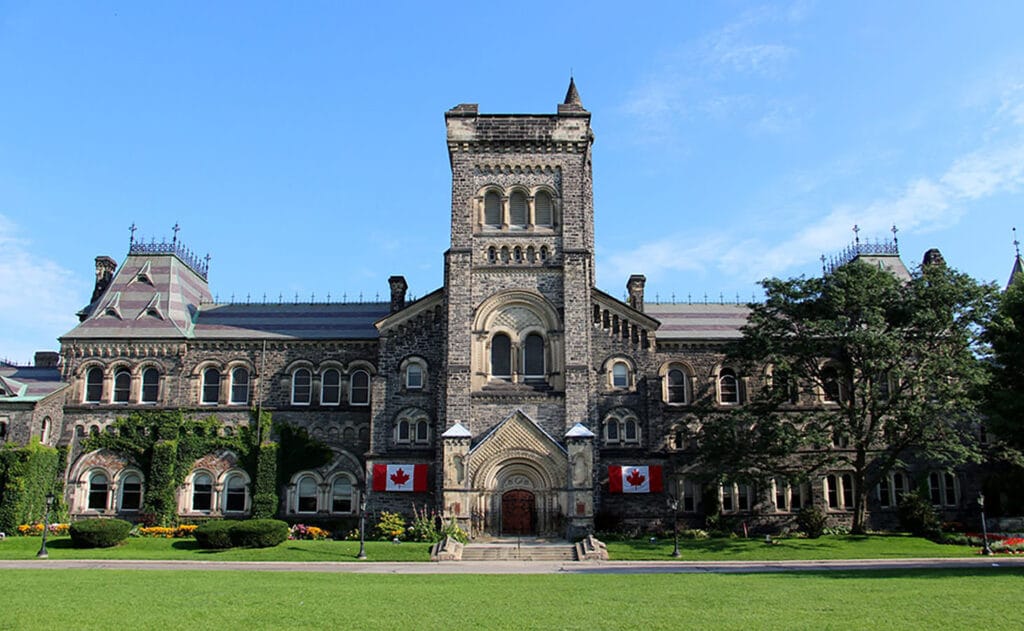Canada has emerged as a leading destination
for international students seeking a high-quality, enriching academic journey.
Fueled by renowned universities, a diverse and welcoming society, and promising
career opportunities, Canada offers a unique and rewarding educational
landscape.
This comprehensive guide serves as your gateway to navigating the Canadian study experience.
Canada: Beyond Poutine &
Hockey for Students
Immerse in a vibrant multicultural society
where food, sports, and affordability collide.
Cuisine Cravings: Forget maple syrup
stereotypes! Canada’s diverse palate boasts French finesse, hearty smoked
meats, and more.
Sports Spirit: Catch an ice hockey game, join a
university club, and experience the unifying power of sports.
Budget-Friendly Education: Canada offers a
relatively affordable study abroad experience compared to others. Expect
$20,000-$30,000 CAD per year (including tuition, living, and accommodation).
Public universities are more budget-friendly, and tuition fees vary.
First-Year Advantage: Many universities offer
subsidized on-campus housing for first-year students, providing convenient
access to classes and a built-in social network.
Canada’s student life is more than just poutine and hockey. It’s a chance to explore, connect, and thrive in a welcoming and diverse environment.
The Canadian Education System
Structure:
The Canadian education system, while varying
slightly by province, generally follows a four-stage structure:

1. Pre-elementary (Optional):
Ages 4-5. Introduces basic skills like counting and alphabets through play and social interaction. Offered in public, private, and federal settings. Free in some provinces.
2. Primary (Mandatory)
Grades 1-6 (Ages 6-12). Focuses on core subjects like math, reading, and science. Students have one teacher for most subjects. Special education options available.
3. Secondary (Mandatory):
Two levels:
- Junior High (Ages 12-14): Grades 7-8. Bridging phase with multiple teachers and classrooms. Prepares students for increased difficulty in high school.
- High School (Ages 14-18): Grades 9-11 (or 12). Students explore diverse subjects, prepare for higher education or careers. Required attendance until age 16 (18 in some provinces).
4. Post-Secondary (Optional):
Colleges and universities offer vocational training, certificates, degrees, and advanced coursework in various fields.
Additional Educational Pathways in Canada

1. Vocational Training:
In addition to vocational programs offered by community colleges, Canada boasts a network of dedicated technical schools specializing in skilled trades and vocations. Traditionally, these programs didn’t require a high school diploma, but recent years have seen increased emphasis on formal qualifications. Vocational schools provide hands-on training under qualified supervisors, equipping students with the skills and experience needed to enter specific trades.
2. Private Schools:
Canada offers a range of private schools, independent institutions not funded by the government. These schools often come with significant tuition fees, and the decision to enroll rests with parents and students. Factors influencing this choice can include smaller class sizes, personalized attention, or specific school philosophies. In Quebec, private schools may be preferred by those seeking English-language instruction.
3. Religious Schools:
With the exception of certain Catholic schools, most religious education in Canada occurs within private institutions. These schools combine the standard academic curriculum with religious teachings and practices aligned with the school’s specific faith tradition.
Languages of Education in Canada
Multilingual Landscape:
Canada celebrates a rich linguistic tapestry,
reflected in its two official languages: English and French. This diversity
extends to education, offering international students and immigrants exciting
choices and experiences.
Regional Variations:
● English Language
Dominance: Across most of Canada, English prevails as the primary language of
instruction in schools.
● French Immersion: Many
schools offer French immersion programs, allowing students to develop fluency
in both languages.
● Quebec’s French Focus:
In Quebec, French reigns supreme. Primary and secondary education is conducted
primarily in French, with exceptions for specific circumstances like temporary
residents.
Immigrant
Integration
Canada warmly welcomes newcomers, with over a
third of young adults hailing from immigrant families. These students
seamlessly integrate into the educational system, achieving success comparable
to their native-born peers. This remarkable adaptability is attributed to
several factors:
● Equal Opportunities:
Canadian schools prioritize fairness and provide equal access to quality
education for all students, regardless of background or origin.
● Supportive Environment:
Schools actively offer support services and language programs to help newcomers
thrive academically and socially.
● Immigrant Drive: Prof.
Jerrim highlights the “immigrant hunger” for success often observed
in these families. Their high expectations and strong work ethic translate into
positive academic outcomes for their children.
The Future
of Canadian Education
Canada’s multilingual education system embraces
diversity and empowers students to navigate an increasingly interconnected
world. By fostering inclusivity and providing equal opportunities, the country
continues to nurture a vibrant and successful educational landscape for all.
Applying to Study in Canada
Start your journey by researching universities
and programs that align with your academic interests and career goals. Consider
factors like program curriculum, faculty expertise, and campus environment.
Meeting Entry Requirements:
Each university has specific requirements for
international students. These typically include:
● Academic transcripts:
Proof of your previous academic performance.
● Language proficiency:
Demonstrating English or French language skills through tests like IELTS or
TOEFL.
● Standardized test
scores: Meeting the required score on tests like SAT or ACT (if applicable).
● Financial
documentation: Showing evidence of sufficient funds to cover tuition and living
expenses.
Preparing Your Application:
Once you’ve chosen your program, carefully
review the application requirements and deadlines. Prepare all necessary
documents, including transcripts, test scores, financial statements, and any
required essays or letters of recommendation.
Submitting Your Application:
Meet the application deadline to avoid delays.
Most universities accept applications online through their official websites.
Study Permit and Visa:
International students typically require a
study permit to stay in Canada while enrolled in a program. You may also need a
Canadian student visa or entry visa, depending on your nationality and program
duration.
Additional Resources:
● Canadian government
website: https://www.canada.ca/en/services/immigration-citizenship.html
● Educanada: https://www.educanada.ca/index.aspx?lang=eng
● University websites:
Each university has its own admissions page with detailed information.
Top-ranked Universities and Colleges in Canada:
Choosing the right university or college in Canada can be
a daunting task. To help you navigate your options, here’s a table showcasing
some of the most highly regarded institutions based on various ranking systems:

| University/College | Location | Ranking Highlights | Program Strengths (Examples) |
|---|---|---|---|
| University of Toronto | Toronto, Ontario | Consistently ranks among the top universities globally. | Medicine, Engineering, Computer Science, Business, Humanities |
| University of British Columbia | Vancouver, British Columbia | Strong research focus and beautiful location. | Forestry, Science, Fine Arts, Geography, Public Health |
| McGill University | Montreal, Quebec | Renowned for its medical school and international student population. | Law, Medicine, Dentistry, Nursing, Education |
| University of Alberta | Edmonton, Alberta | Leading research institution with strong ties to industry. | Engineering, Medicine, Agriculture, Energy, Business |
| McMaster University | Hamilton, Ontario | Innovative approach to education with a focus on hands-on learning. | Engineering, Science, Health Sciences, Nursing, Social Work |
| University of Waterloo | Waterloo, Ontario | World leader in technology and innovation, particularly in computer science. | Engineering, Computer Science, Mathematics, Nanotechnology, Quantum Computing |
| University of Ottawa | Ottawa, Ontario | Bilingual university with a focus on public policy and international relations. | Law, Medicine, Education, Engineering, Business |
| Queen's University at Kingston | Kingston, Ontario | Known for its beautiful campus and strong academic program. | Arts & Science, Engineering, Medicine, Law, Business |
| University of Calgary | Calgary, Alberta | Leading research university with strengths in energy, health, and the environment. | Engineering, Medicine, Veterinary Medicine, Law, Business |
| University of Montreal | Montreal, Quebec | Largest French-language university in North America. | Law, Medicine, Business, Arts & Science, Engineering |
Additional resources to explore:
- Maclean’s University Rankings: https://education.macleans.ca/rankings/
- QS World University Rankings: https://www.topuniversities.com/student-info/choosing-university/worlds-top-100-universities
- Times Higher Education World University Rankings: https://www.timeshighereducation.com/world-university-rankings
Post-Graduation Options in Canada: Work, Research, and Beyond
Graduating from a Canadian university unlocks a range of exciting possibilities. Your academic journey can lead to employment opportunities, continued research in academia, or even permanent residency.
Postgraduate Work Permit: Upon graduation, you may be eligible for the Post-Graduate Work Permit Program, allowing you to work in Canada for up to three years and gain valuable experience.
Academic Pursuits: Canada offers a stimulating environment for pursuing doctoral studies. Compared to some other destinations, PhD programs here can be more affordable, and some universities may even offer special incentives for outstanding international students. Completing a doctorate grants you an additional three years of work authorization in Canada, opening doors to permanent residency and citizenship pathways.
Job Market Navigation: Canada’s economy comprises five key sectors: services, agriculture, technology, energy, and manufacturing. Different provinces offer distinct opportunities – for example, Alberta boasts a thriving energy sector, while Manitoba has dedicated programs to attract international talent for specific industries. To navigate this diverse landscape, many Canadian universities provide career services and mentoring resources to help graduates find their professional footing.










